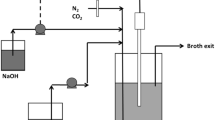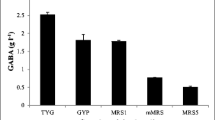Abstract
In batch and continuous cultivations ofClostridium acetobutylicum ATCC 824 on lactose, a strong relationship was observed between redox potential of broth and the cellular metabolism. The specific productivity of butanol as well as of butyric acid was found to be maximum at a redox potential of -250 mV. The specific production rate of butyric acid decreased rapidly at redox potentials. For butanol, however, it achieved a lower but stable value. This was true for dynamic as well as steady states. The continuous fermentations involving lactose exhibited sustained oscillations at low dilution rates. These oscillations appear to be related to butanol toxicity to the growth of cells. At higher dilution rates where butanol concentrations were relatively low, no such oscillations were observed. It can be concluded that broth redox potential is an excellent indicator of the resulting fermentation product partitioning.
Similar content being viewed by others
References
Johnson, M. J., Peterson, W. H., and Fred, E. B. (1931),J. Biol. Chem.,91, 569.
Beesch, S. C. (1953),Appl. Microbiol.,1, 85.
Bahl, H., Andersch, W., and Gottschalk, G. (1982),Eur. J. Appl. Microbiol. Biotechnol,15, 201.
Gapes, J. R., Larson, V. F., and Maddox, I. S. (1982), “Microbial production ofn-butanol: some problems associated with the fermentation,” pp. 90–101. In “Energy from biomass,” Proceedings of the 14th Biotechnology Conference, Palmerston North, New Zealand (1982).
Gottschal, J. C, and Morris, J. G. (1981),FEMS Microbiol. Lett.,12, 385.
Martin, J. R., Petitdemange, H., Ballongue, J., and Gay, R. (1983),Biotechnol. Lett.,5, 89.
Jones, D. T., and Woods, D. R. (1986),Microbiol. Rev.,50, 484.
Kim, B. H., Bellows, P., Datta, R., and Zeikus, J. G. (1984),Appl. Environ. Microbiol.,48, 764.
Bahl, H., Gottwald, M., Kuhn, A., Rale, V., Andersch, W., and Gottschalk, G. (1986),Appl. Environ. Microbiol.,52, 169.
Aubel, E., Rosenberg, A. J., and Grunberg, M. (1946),Helv. Chim. Act.,29, 1267.
Douglas, F., and Rigby, G. J. (1974),J. Appl. Bad.,37, 251.
Hungate, R. E. (1950),Bacteriol. Rev.,14, 1–49.
Nelson, N. (1944),J. Biol. Chem.,153, 375.
Herrero, A. A. (1983),Trends Biotechnol.,1, 49.
Haggstrom, L. (1985),Biotechnol. Adv.,3, 13.
van Uden, N. (1985),Ann. Rep. Ferment. Processes,8, 11.
Ounine, K., Petitdemange, H., Raval, G., and Gay, R. (1985),Appl. Environ. Microbiol.,49, 874.
Andersch, W., Bahl, H., and Gottschalk, G. (1983),Eur. J. Appl. Microbiol. Biotechnol.,18, 327.
Kim, B. H., and Zeikus, J. G. (1985),Dev. Ind. Microbiol.,26, 1.
George, H. A., and Chen, J. S. (1983),Appl. Environ. Microbiol.,46, 321.
Douglas, F., Hambleton, R., and Rigby, G. J. (1974),J. Appl. Bacteriol.,36, 625.
Dutta, R., and Zeikus, J. G. (1985),Appl. Environ. Microbiol.,49, 522.
Meyer, C. L., Mclaughlin, J. K., and Papautsakis, E. T. (1985),Biotechnol. Lett.,7, 37.
Doremus, M. G., Linden, J. C, and Moreira, A. R. (1985),Biotechnol. Bioeng.,27, 259.
Eliasberger, P. S., (1930),Biochem. Z.,220, 259.
Yerushalmi, L., Volesky, B., and Szczesny, T., (1985),Appl. Microbiol. Biotechnol.,22, 103.
Jungerman, K., Thauer, R. K., Leimenstoll, G., and Decker, K. (1973),Biochim. Biophys. Acta,305, 268.
Huang, L., Gibbons, L. N., and Forsberg, C. W. (1985),Appl. Environ. Microbiol.,50, 1043.
Fond, O., Matta-Ammouri, G., Petitdemange, H., and Engasser, E. (1985),Appl. Microbiol. Biotechnol.,22, 195.
Author information
Authors and Affiliations
Rights and permissions
About this article
Cite this article
Kim, J., Bajpai, R. & Iannotti, E.L. Redox potential in acetone-butanol fermentations. Appl Biochem Biotechnol 18, 175–186 (1988). https://doi.org/10.1007/BF02930824
Issue Date:
DOI: https://doi.org/10.1007/BF02930824




